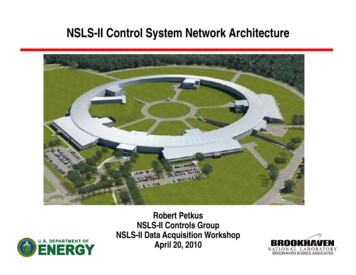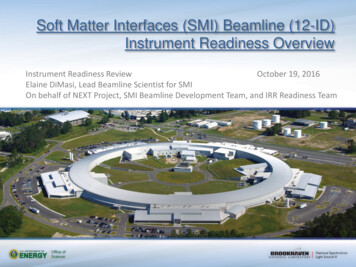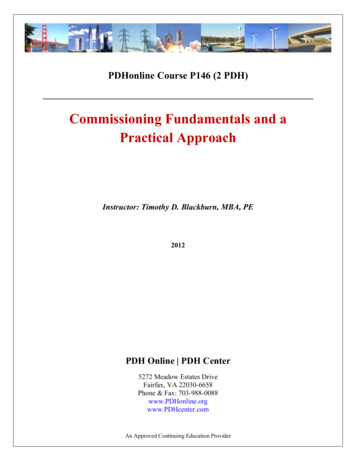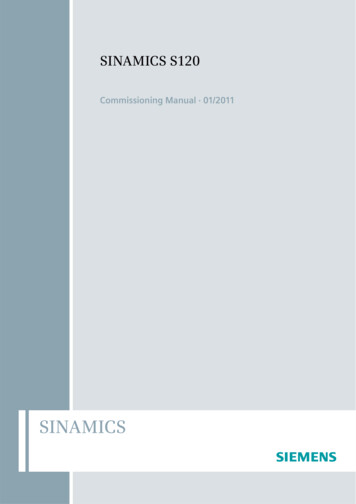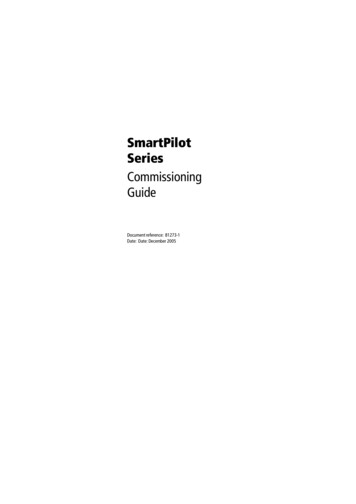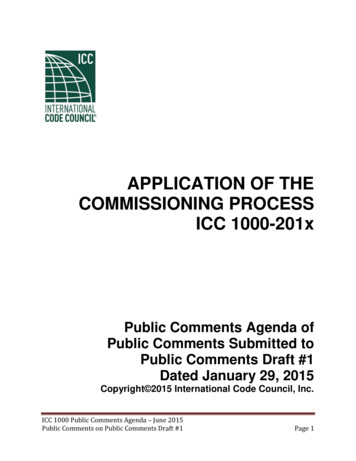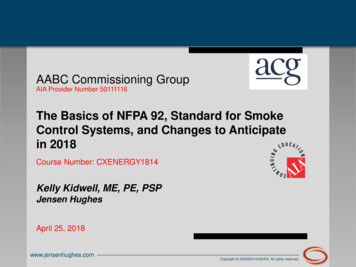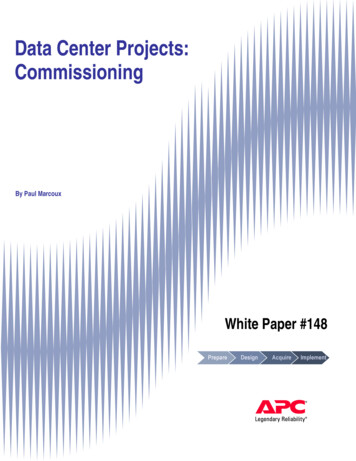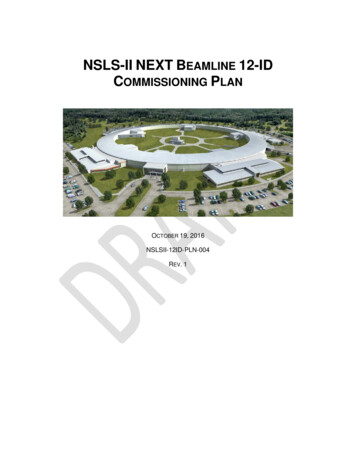
Transcription
NSLS-II NEXT BEAMLINE 12-IDCOMMISSIONING PLANOCTOBER 19, 2016NSLSII-12ID-PLN-004REV. 1
iNational Synchrotron Light Source IINSLS-II NEXT BEAMLINE 12-IDCOMMISSIONING PLANOCTOBER 19, 2016PREPARED BY:XElaine DiMasiSMI Lead Beamline ScientistAPPROVED BY:XPaul ZschackPhoton Science Division Director
iiNational Synchrotron Light Source IIREVISION HISTORYREVISION1DESCRIPTIONDATEOctober 19, 2016First IssueAcronyms13DOF 13 Degree of FreedommABDMBounce Down MirrorMAXS Medium-angle X-ray ScatteringBNLBrookhaven National LaboratoryNEXTCRLsCompound Refractive LensesNSLS-II National Synchrotron Light Source IIEPSEquipment Protection SystemPASSProposal, Allocation, Safety and SchedulingESHEnvironment, Safety and HealthPPSPersonnel Protection SystemESRExperiment Safety ReviewPSDPhoton Science DivisionFEFront EndRGAResidual Gas AnalyzerSAFSafety Approval FormSAXSSmall-angle X-ray ScatteringSMISoft Matter InterfacesTCPTechnical Commissioning PlanFLUKA Fluktuierende Kaskade (Monte Carlosimulation software)GIGrazing IncidenceGVGate ValveIDInsertion DeviceIRRInstrument Readiness Reviewmilli-AmpereNSLS-II Experimental Tools ProjectWAXS Wide-angle X-ray ScatteringXBPM X-ray Beam Position Monitor
Table of MLINE COMMISSIONING13.13.23.3222Radiation Survey CommissioningTechnical CommissioningScientific Commissioning4.COMMISSIONING ACTIVITY APPROVAL35.END STATION EQUIPMENT ADDITIONS36.END OF COMMISSIONING; TRANSITION TO OPERATIONS47.SMI BEAMLINE TECHNICAL COMMISSIONING PLAN57.17.27.37.3.17.3.27.3.37.3.48SMI Beamline Subsystem DefinitionSMI Beamline Commissioning Without BeamSMI Beamline Commissioning With BeamPre-beam Commissioning ActivitiesFirst-beam Extraction and Radiation SurveysBeamline Optics Commissioning & Transition to Operation ConditionExperimental Station and Data Acquisition Commissioning56778111420REFERENCES21Appendix A: SMI Beamline Component Layoutiii
11.National Synchrotron Light Source IIINTRODUCTIONThis plan outlines the actions needed to commission the NSLS-II NEXT 12-ID (Soft Matter Interfaces,SMI) Beamline from the accelerator enclosure ratchet wall to the endstation. Once the readinessprocess is complete and authorization to begin commissioning the beamline is received, the technicalcommissioning will proceed, initially hand in hand with a radiation safety commissioning, until thebeamline is deemed to be radiation safe in standard x-ray operations. In the latter stages of technicalcommissioning, the main optical elements of the beamline are optimized for User Operations, andfinally the end-stations are also commissioned. There are several processes established to manage therisks associated with this task, which are outlined below.The scope of this plan includes managing specific commissioning activities for the beamline,reviewing requirements for equipment not needed for commissioning, but planned for operations, andthe basis for transitioning to operations. Technical commissioning of the FEs and IDs is managedseparately from the beamline.2.SHIELDINGRay tracing and computer modeling (FLUKA) indicate that 12-ID is shielded for the maximumplanned stored electron beam current of 500 mA. The primary Gas Bremsstrahlung ray traces havebeen completed in accordance with Synchrotron and Bremsstrahlung Ray Trace Procedure (PS-CXFD-PRC-008) and Insertion Device Front End Ray Tracing Procedure (PS-C-ASD-PRC-147) andtop-off safety analyzed, resulting in one Bremsstrahlung collimator and a Bremsstrahlung stop withinthe 12-ID-A hutch. Two Secondary Gas Bremsstrahlung shields were designed following NSLS-IIguidelines. The scattering of Bremsstrahlung has been modeled using FLUKA, which showed that thesecondary shields are adequate at 500 mA beam current. The summary of these simulations includingthe simulation of the monochromatic beam containment in beam transport and endstation enclosuresare provided in 12-ID SMI Beamline Radiation Shielding Analysis (Tech Note #228).3.BEAMLINE COMMISSIONINGThe commissioning of the SMI beamline and its transition to operations begins with the IRR. This willbe followed by the first two phases of the Technical Commissioning Plan (TCP) in which the electronbeam current is gradually increased while monitoring equipment safety. The TCP is conducted inparallel with Radiation Survey Commissioning, which monitors radiation safety as the ring current isincreased. When the beamline equipment has been demonstrated to be capable of safely operatingduring standard x-ray operations, there is a final comprehensive radiation survey. The TCP thenmoves on to a new phase, in which all the key optical components such as the monochromator andmirrors are commissioned in detail in order to determine optimal operating parameters. In a final phaseof the TCP, the endstations are commissioned. Scientific commissioning will then follow, with the1
2National Synchrotron Light Source IIparticipation of expert users, to verify that the beamline meets the design performance goals and tobuild up endstation and beamline parameters and configurations that optimize beamline performancefor routine user operations.3.1Radiation Survey CommissioningA comprehensive SMI Beamline (12-ID) Radiation Survey Procedure (NSLSII-12ID-PRC-001) wasdeveloped in accordance with NSLS-II Beamlines Radiation Safety Commissioning Plan (PS-C-XFDPRC-004), which guides the steps needed to control radiological hazards. It includes specific holdpoints to manage identified radiation risks and maintain commissioning within an approved envelope.The Radiation Survey Procedure requires participation and coordination between Beamline,Operations, Radiological Control, and ESH Staff. It identifies specific radiation scatter points along thebeamline and provides instruction for mechanical manipulation of the optics to allow for acomprehensive radiological survey along the beamline. Execution of the Radiation Survey Procedure,along with the evaluation of the data collected, will be used as a basis by the PSD Director and ESHManager to approve commissioning activities at an electron beam current of up to 3 times the electronbeam current measured during the survey. Approval of commissioning of the beamline at a higherelectron beam current requires re-execution of the Radiation Survey Procedure. The maximum currentallowed during commissioning is indicated on the Caution Tag that is applied by Operations Staff tothe beamline enable key. Enabling the beamline at a higher current requires re-execution of the fullRadiation Survey Procedure and re-approval by the PSD Director and ESH Manager.3.2Technical CommissioningThe Technical Commissioning Plan (TCP), described in Section 7 below, documents in some detail thesequence of activities planned to safely commission the beamline. The TCP starts with lowest ringcurrent, and gradually increases ring current until it is at the value for standard operations. At thecompletion of TCP, all major beamline components will be ready to use, and parameters that optimizetheir performance will be documented.3.3Scientific CommissioningThe SMI beamline will have two experimental endstations. Enclosure 12-ID-B allows diagnostic worksuch as measurement of primary focus of the x-ray beam and will eventually be dedicated to anindependent outboard branch line in the canted sector 12-ID. No installed instrumentation iscommissioned in 12-ID-B in the scope of the NEXT Project or this TCP. Enclosure 12-ID-C willenable grazing incidence small-angle and wide-angle x-ray scattering (GI-SAXS/WAXS) experiments.12-ID-C instrumentation is installed in the scope of the NEXT Project. A scientific commissioningplan will be developed while the technical commissioning takes place. The goal of the scientificcommissioning will be to define the beamline parameters and configurations needed for the anticipatedscientific program, and the process to bring the complete beamline into routine operations for users.2
34.National Synchrotron Light Source IICOMMISSIONING ACTIVITY APPROVALWork planning needed for safe and efficient commissioning, requires a commissioning SAF and isperformed in accordance with Experiment Safety Review (PS-C-ESH-PRC-039). This process drivesdefinition of scope, identification of hazards and controls, and review and approval requirements forall commissioning activities. A commissioning SAF describing the commissioning tasks to beundertaken by the commissioning team will be submitted. This form will include the equipment andmaterials that will be used, the personnel authorized to participate in the commissioning and anycontrols that will be placed on the beamline (such as a current limit). This form will be submitted tothe ESH Manager and PSD Director for approval. This commissioning activity approval processauthorizes the commissioning team for a specific task or tasks (such as performing a radiation survey)thereby enforcing a step-by-step and HOLD point approach to commissioning. Most commissioningtasks are expected to take approximately one week to complete, though some may be longer. Allcommissioning activities will be reviewed on a weekly basis to determine if a new commissioningSAF is needed. This allows for flexibility in the commissioning process, but at the same time ensuresthat during commissioning the work is periodically reviewed and that the necessary controls are placedon the commissioning activities.An approved commissioning SAF is required for the beamline to be enabled. Beamline enable ismanaged in accordance with Enabling Beamlines for Operations (PS-C-XFD-PRC-003). Thisprocedure defines the process for enabling the beamline safety shutter and for giving control of thatshutter to the Beamline Staff. The process requires participation and coordination between Beamline,Operations, and ESH Staff. A checklist is employed to assure systems are ready (PPS and safetysystem configuration control) and that staff is prepared to begin.5.END STATION EQUIPMENT ADDITIONSExperimental modules will be added to the end station as commissioning moves from technical toscientific, and the focus is shifted to optimizing the photon beam and preparing end stationinstrumentation for the expected scientific program. All equipment will be added in accordance withthe NSLS-II Process Description: Review Process for Facility Additions and Modifications (PS-CCMD-PLN-001), which provides a process for determining the type and extent of reviews warranted.The end station equipment additions for the beamline have been evaluated and it has been determinedthat the addition of this equipment will not constitute a sufficient modification of the beamlineinstrument, and therefore will not require an IRR. These additions will be reviewed through the BNLESR process, in accordance with Experiment Safety Review (PS-C-ESH-PRC-039). This system allowsfor the treatment of the end stations as experiment areas and provides an electronic mechanism togather the information needed to define and review equipment and materials in that area. The BNLESR system contains fields for entry of the equipment and materials to be used, task analyses, controlrequirement definition, and for ESH review and approval. This approach will be documented in a3
4National Synchrotron Light Source IITailored Review Plan in accordance with the NSLS-II Process Description: Review Process forFacility Additions and Modifications (PS-C-CMD-PLN-001).The ESRs will be posted at the end station so that they are readily available and provide an ESHenvelope of the allowed equipment and activities in the area. This system is used in experiment spacesthroughout BNL. Annual review and approval is required, but any change also triggers a systemupdate with an approval requirement. This system will assure careful management of equipmentadditions and will be correlated with the ESR process planned for the management of User activities.6.END OF COMMISSIONING; TRANSITION TO OPERATIONSCommissioning ends when the beamline has shown, through the execution of procedures and surveys,that it meets the NSLS-II Shielding Policy, that radiation leakage or scatter is controlled to as low asreasonably achievable, that the photon beam is ready for data collection, and that the necessaryauthorizations for beginning operations have been obtained. Prior to the beamlines commencing UserOperations, the process outlined in Beamline User Readiness (PS-C-XFD-PRC-030) will becompleted.The safety of ongoing beamline operations will be managed with the Experiment Safety Review (PS-CESH-PRC-039) process, which will control materials, equipment, and tasks at the end station areasthrough the use of the BNL electronic ESR system. A Cognizant Space Manager is assigned to the areaand has responsibility to assure that the system is current and accurate. This system provides avaluable envelope for the resources and allows operations at each location.Individual experiments will be managed with the electronic SAF section of PASS; a system forProposal, Allocation, Safety, and Scheduling for User science. The SAF will allow collection ofinformation specific to each experiment and will be reviewed by NSLS-II Staff to determine whathazards are outside the safety envelope established. The SAF will provide the mechanism fordefinition of scope, analysis of hazards, establishment of controls, and collection of feedback for eachexperiment. Users must identify the materials and equipment they wish to bring along with a taskanalysis describing how those items will be used. An iterative review between the User, Beamline, andESH Staff results in a final approval with definition of requirements.The SAF process combined with the BNL ESR safety envelope provides the basis needed to assureongoing control of beamline operation and changes. No additional readiness reviews are expected forthe 12-ID at this time.4
5National Synchrotron Light Source II7.SMI BEAMLINE TECHNICAL COMMISSIONING PLAN7.1SMI Beamline Subsystem DefinitionRefer to Appendix A, SMI Beamline Component Layout, for context.12-ID-Aa. Differential Pumping Assembly: First and second ion pump crosses, with RGA at first cross downstream of ratchet wall GV-2 Water-cooled Fixed Aperture Mask (FAM) and PPS Aperture GB Collimatorb. White Beam Slits (WB Slits) slit photocurrent diagnosticc. White Beam Stopd. Gaseous Bremsstrahlung Stop (GB Stop)e. Double Crystal Monochromator (DCM), fixed exit Si(111), 25mm bounce-upf. X-ray Beam Position Monitor 1 (XBPM1), instrumented diamond, thin window for tender x-rays,NEXT Project scope, ESR to be submitted after IRR approvalg. Horizontal Focusing Mirror (HFM), bimorph, reflects inboard, incorporating horizontalmonochromatic beam slits (H slits) before the mirror and a stripe photocurrent diagnostich. Vertical Focusing Mirror (VFM), bimorph, reflects up, incorporating vertical monochromatic beamslits (V slits) before the mirror. Vessel contains an RGAi. Vertical Deflection Mirror (VDM), flat, reflects down, in same vacuum vessel following VFMj. X-ray Beam Position Monitor 2 (XBPM2), instrumented diamond, thin window for tender x-raysk. Photon Shutter (PSH) for monochromatic beam12-ID-B-1l. X-ray Beam Position Monitor 3 (XBPM3), instrumented diamond, thin window for tender x-raysm. Secondary Source Aperture (SSA) slit photocurrent diagnostic12-ID-Bn. Removable Shielded Beampipe, incorporates PPS interlocks to detect configuration and enableshutter logic for access to 12-ID-B while taking beam in 12-ID-Co. Removable Beam Stop Block, incorporates PPS interlocks to detect configuration and enableshutter logic for access to 12-ID-C while taking beam in 12-ID-B. A Be Window terminates theupstream part of the vacuum line when the Beam Stop Block is in use.5
6National Synchrotron Light Source II12-ID-Cp. Installed beam transport from upstream includes ion pump crosses and reserves space for futurebeam conditioning elements.q. CRL Transfocator, provides microfocus. Lenses can be extracted entirely from the beamr. WAXS Assembly: Sample Vacuum Chamber, equipped with EPX dry turbo pump WAXS Goniometer, arc stage for Wide Angle Detector motion Pilatus 300K-W detector, NEXT Project scope, ESR to be submitted after IRR approval Vacuum Sample Stages, 13 degree of freedom (13DOF) hexapod based sample positioner Bounce Down Mirror (BDM), coated silicon for grazing incidence onto liquidss. SAXS Assembly: NEXT Project scope, ESR to be submitted after IRR approval SAXS Beam Chamber, equipped with EPX dry turbo pump Beam Stop Assembly, small stops to block direct beam on SAXS detector, equipped withdiode and photocurrent diagnostics Detector XYZ Mechanics Pilatus 1M detectort. Rayonix MAXS (Medium Angle) detector supplied by CFN Partner (not shown in layout)7.2SMI Beamline Commissioning Without BeamThe majority of these tasks will be accomplished prior to IRR, and documented in executed travelers.a. Vacuum Systems: all pumps, gauges, and valves functional with readouts in EPS systemb. White Beam Components package:1. Motors, temperature sensors, and other signals functioning for WB Slits and DCM2. Cryo-Cooler test and DCM cold test3. PPS and EPS utilities and systems including PPS Aperture manifold tested and ready4. Camera viewing phosphor plates on WB Stop5. EPICS functionality of DCM geometry / energy code installed / tested6. Verify the functionality of the CSS screensc. H-V Mirror and SSA package1. Motors, temperature sensors, and other signals functional for slits and mirrors2. Bimorph mirror high voltage controller interfaced and tested6
7National Synchrotron Light Source IId. Photon Shutter interfaced and testede. CRL Transfocator interfaced and testedf. WAXS Assembly:1. Sample Vacuum Chamber vacuum tests2. WAXS Goniometer interfaced and tested3. Pilatus 300K-W interfaced and tested, including utilities, triggers, and data servers4. Bounce Down Mirror controller tested, incorporated into EPICS5. Sample Vacuum Stages tested, incorporated into EPICS6. Cable management completeg. SAXS Assembly:1. SAXS Beam Chamber installed and surveyed2. SAXS detector XYZ mechanics installed and tested3. Pilatus 1M interfaced and tested, including utilities, triggers, and data servers4. Beam stop assembly tested, signals incorporated into EPICS as detectors5. Cable management completeh. Data Acquisition1. Motor scan and scaler setup and test2. Area detector EPICS setup and test3. Verify scripting capabilities and high-level control GUIs7.3SMI Beamline Commissioning With Beam7.3.1Pre-beam Commissioning ActivitiesThe in-vacuum undulator (IVU) source has been installed at 12-ID and has been commissioned by theAccelerator Division during February-September 2016.Prior to the beamline commissioning activities, the following prerequisites shall be satisfied: IRR completed and pre-start findings closed PPS and EPS functional Accelerator operating at current determined by the accelerator division IVU source and front end commissioned7
8National Synchrotron Light Source II Front end slits controllable by beamline control system, slit-current reading functional Cameras connected and working to align beam with respect to visualization screens Beamline control environment with basic capabilities (including motor control and scanning)and basic graphics and user interface available For a given commissioning-with-beam activity, relevant commissioning-without-beamactivities are completed7.3.2First-beam Extraction and Radiation SurveysInitial activities are carried out in support of the SMI Radiation Survey Procedure (NSLSII-12ID-PRC001), which is organized as follows:I.GB Radiation Surveya. Integrity of enclosure 12-ID-A, GB on fixed componentsb. GB on movable components (WB Slits, DCM)II.White Beam Radiation Surveya. Integrity of enclosure 12-ID-A, white beam on fixed components (FAM, WB Stop)b. White beam on movable components (WB Slits, DCM)III.Monochromatic Beam Radiation Surveya. Integrity of enclosure 12-ID-A and trans
A comprehensive SMI Beamline (12-ID) Radiation Survey Procedure (NSLSII-12ID-PRC-001) was developed in accordance with NSLS-II Beamlines Radiation Safety Commissioning Plan (PS-C-XFD- PRC-004), which
